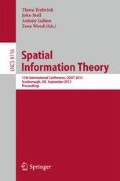Abstract
This study addressed the issue of spatial concepts by examining the perception of changes in shape, orientation, size, and cyclic order caused by the transformations of deformation, rotation, scaling, and reflection. 49 participants viewed 36 geometric configurations to which different types and degrees of transformations were applied, and answered how much they thought the configurations were different from each other. Participants perceived deformed configurations as more dissimilar as the degree of deformation became larger. Participants’ perception of geometric properties, however, did not conform to the mathematical classification of transformations. They discriminated between deformed, rotated, scaled, and reflected configurations when the degree of deformation was small; but the perceived difference became smaller as the degree of deformation became larger. Furthermore, mental-rotation ability affected the sensitivity to geometric properties, with low-spatial people attending to changes in orientation caused by rotation and reflection. Implications for spatial learning and education are discussed.
Access this chapter
Tax calculation will be finalised at checkout
Purchases are for personal use only
Preview
Unable to display preview. Download preview PDF.
References
Casey, M.B., Nuttall, R.L., Pezaris, E.: Mediators of gender differences in mathematics college entrance test scores: A comparison of spatial skills with internalized beliefs and anxieties. Developmental Psychology 33, 669–680 (1997)
Ekstrom, R.B., French, J.W., Harman, H.H., Dermen, D.: Kit of Factor-Referenced Cognitive Tests. Educational Testing Service, Princeton (1976)
Gans, D.: Transformations and Geometries. Appleton-Century-Crofts, New York (1969)
Gersmehl, P.J., Gersmehl, C.A.: Spatial thinking by young children: Neurologic evidence for early development and “educability”. Journal of Geography 106, 181–191 (2007)
Gescheider, G.A.: Psychophysics: The Fundamentals, 3rd edn. Erlbaum, Mahwah (1997)
Girden, E.R.: ANOVA: Repeated Measures (Sage University Paper Series on Quantitative Applications in the Social Sciences, Series No. 07–084). Sage, Newbury Park (1992)
Golledge, R.G.: Do people understand spatial concepts: The case of first-order primitives. In: Frank, A.U., Formentini, U., Campari, I. (eds.) GIS 1992. LNCS, vol. 639, pp. 1–21. Springer, Heidelberg (1992)
Golledge, R.G.: The nature of geographic knowledge. Annals of the Association of American Geographers 92, 1–14 (2002)
Golledge, R.G., Marsh, M., Battersby, S.: A conceptual framework for facilitating geospatial thinking. Annals of the Association of American Geographers 98, 285–308 (2008)
Goodchild, M.F.: The fourth R? Rethinking GIS education. Arc News 28(3), 11 (2006)
Hegarty, M.: Components of spatial intelligence. Psychology of Learning and Motivation 52, 265–297 (2010)
Hegarty, M., Montello, D.R., Richardson, A.E., Ishikawa, T., Lovelace, K.: Spatial abilities at different scales: Individual differences in aptitude-test performance and spatial-layout learning. Intelligence 34, 151–176 (2006)
Hegarty, M., Richardson, A.E., Montello, D.R., Lovelace, K., Subbiah, I.: Development of a self-report measure of environmental spatial ability. Intelligence 30, 425–447 (2002)
Ishikawa, T.: Geospatial thinking and spatial ability: An empirical examination of knowledge and reasoning in geographical science. The Professional Geographer (2012) (in press; first published online), doi:10.1080/00330124.2012.724350
Ishikawa, T., Kastens, K.A.: Why some students have trouble with maps and other spatial representations. Journal of Geoscience Education 53, 184–197 (2005)
Janelle, D.G., Goodchild, M.F.: Location across disciplines: Reflection on the CSISS experience. In: Scholten, H.J., Velde, R., Manen, N. (eds.) Geospatial Technology and the Role of Location in Science, pp. 15–29. Springer, Dordrecht (2009)
Keehner, M.M., Tendick, F., Meng, M.V., Anwar, H.P., Hegarty, M., Stoller, M.L., Duh, Q.: Spatial ability, experience, and skill in laparoscopic surgery. American Journal of Surgery 188, 71–75 (2004)
Kidder, F.R.: Elementary and middle school children’s comprehension of Euclidean transformations. Journal of Research in Mathematics Education 7, 40–52 (1976)
Klippel, A., Weaver, C., Robinson, A.: Analyzing cognitive conceptualizations using interactive visual environments. Cartography and Geographic Information Science 38, 52–68 (2011)
Kozhevnikov, M., Motes, M., Hegarty, M.: Spatial visualization in physics problem solving. Cognitive Science 31, 549–579 (2007)
Kruskal, J.B.: Multidimensional scaling by optimizing goodness of fit to a nonmetric hypothesis. Psychometrika 29, 1–27 (1964)
Kuhn, W.: Core concepts of spatial information for transdisciplinary research. International Journal of Geographical Information Science 26, 2267–2276 (2012)
Lee, J., Bednarz, R.: Components of spatial thinking: Evidence from a spatial thinking ability test. Journal of Geography 111, 15–26 (2012)
Levinson, S.C.: Frames of reference and Molyneux’s question: Cross-linguistic evidence. In: Bloom, P., Peterson, M., Nadel, L., Garrett, M. (eds.) Language and Space, pp. 109–169. MIT Press, Cambridge (1996)
Liben, L.S., Downs, R.M.: Understanding person-space-map relations: Cartographic and developmental perspectives. Developmental Psychology 29, 739–752 (1993)
Mandler, J.M.: Representation. In: Mussen, P.H. (ed.) Handbook of Child Psychology, 4th edn., pp. 420–494. Wiley, New York (1983)
Mandler, J.M.: On the spatial foundations of the conceptual system and its enrichment. Cognitive Science 36, 421–451 (2012)
Manduca, C., Mogk, D., Stillings, N.: Bringing Research on Learning to the Geosciences. Science Education Resource Center, Carleton College (2003)
Martin, J.L.: A test with selected topological properties of Piaget’s hypothesis concerning the spatial representation of the young child. Journal of Research in Mathematics Education 7, 26–38 (1976)
National Research Council: Learning to Think Spatially. National Academies Press, Washington, DC (2006)
Newcombe, N.S.: Increasing math and science learning by improving spatial thinking. American Educator 34(2), 29–43 (2010)
Piaget, J., Inhelder, B.: The Child’s Conception of Space (trans. Langdon, F.J., Lunzer, J.L.). Norton, New York (1967; original work published 1948)
Siegel, A.W., White, S.H.: The development of spatial representations of large-scale environments. Advances in Child Development and Behavior 10, 9–55 (1975)
Uttal, D.H., Cohen, C.A.: Spatial thinking and STEM education: When, why, and how? Psychology of Learning and Motivation 57, 147–181 (2012)
Author information
Authors and Affiliations
Editor information
Editors and Affiliations
Rights and permissions
Copyright information
© 2013 Springer International Publishing Switzerland
About this paper
Cite this paper
Ishikawa, T. (2013). Spatial Primitives from a Cognitive Perspective: Sensitivity to Changes in Various Geometric Properties. In: Tenbrink, T., Stell, J., Galton, A., Wood, Z. (eds) Spatial Information Theory. COSIT 2013. Lecture Notes in Computer Science, vol 8116. Springer, Cham. https://doi.org/10.1007/978-3-319-01790-7_1
Download citation
DOI: https://doi.org/10.1007/978-3-319-01790-7_1
Publisher Name: Springer, Cham
Print ISBN: 978-3-319-01789-1
Online ISBN: 978-3-319-01790-7
eBook Packages: Computer ScienceComputer Science (R0)

